
Consume crispy and fresh
Tender Swiss chard leaves that grow in your own bed are crisp, fresh and full to the brim with vitamins. Processing them into delicious dishes in this condition is ideal.
also read
- Storing Swiss chard - tips for storage
- Growing dates for Swiss chard
- Wintering chard properly
So only pick these vegetables if you will use them for cooking immediately afterwards. This also applies to sensible freezing when the harvest quantity exceeds current consumption.
With supermarket goods, you should also pay attention to freshness. The main summer season seduces with low prices. But the warm air temperature quickly causes a loss of moisture and causes the leaves to wither. Buy only plump-looking Swiss chard and stock up on cheap, frozen supplies for the winter.
The best method of preservation: freezing
Always keep in mind that fresh Swiss chard can only be stored temporarily in the refrigerator for a very short time. If you can already foresee that the preparation will not be possible as quickly as possible, you will need another storage method. Freezing is then the salvation as it can save most of the valuable ingredients and even the green color for a long time.
Prepare leaves
- Cut off any dry stem ends.
- Wash the chard thoroughly several times until no more earth or sand remains on the leaves.
- Separate thick stems from the green leaves.
- Cut the stems into small, bite-sized pieces.
- Depending on your preference, cut the leaves into fine or coarse strips. Don't mix these with the stems just yet.
Blanch first, then freeze
The tender leaves and thick stems must be put in boiling water separately, as they take different lengths of time.
- Blanch the stems for 2-3 minutes
- Blanch the leaves for 1 minute
- in a large saucepan with lightly salted water
- Quench in ice water
The hot bath offers these advantages
The features listed below that blanching gives frozen vegetables speak convincingly in favor of this step:
- the color is retained
- Swiss chard “shrinks” and takes up less space in the chest
- Vitamins are spared
Freeze Swiss chard properly
The blanched and cooled chard should first drain well. It can also be gently patted dry with kitchen paper.
Divide the amount of chard into smaller portions. Put them in suitable, well-sealable containers. In terms of environmental friendliness, these can also be made of glass. Cleaned jam jars, for example, are ideal as containers for frozen food.
Tips
Do not fill glasses to the brim as the frozen contents will expand a little. They could burst in the freezer.
Shelf life and thawing
Frozen Swiss chard can be left in the freezer for 8 to 12 months. It does not have to thaw, but can be frozen in the cooking food. It will continue to cook in it within a few minutes.
Conclusion for quick readers
- Preservation: Fresh Swiss chard cannot be stored for long, so freezing is the best preservation method
- Ideal time: Summer is chard season and the ideal time to freeze excess harvest or cheap shopping
- Prerequisite: Only fresh and crisp leaves offer the best quality, also for the freezer
- Preparation: cut off dry stem ends; Wash the Swiss chard thoroughly; Separate the stems from the green
- Preparation: cut stems into bite-sized pieces, cut leaves into strips; Do not mix leaves and stems
- Blanching: Put in salted and boiling water; Cook stalks for 2 to 3 minutes; Leaves only 1 minute
- Quenching: Put the blanched Swiss chard directly into ice water and cool it down; then take it out immediately
- Advantages: color is retained; Vitamins are spared; “Shrunken” Swiss chard takes up less space
- Portioning: First allow the Swiss chard to drain well; then divide into smaller portions;
- Filling: fill suitable containers with Swiss chard; Environmental aspects also speak in favor of glass glasses
- Tip: do not fill the glass container to the brim; Frozen food expands and can burst
- Freezing: Label container with contents and date; Place in the freezer immediately
- Shelf life: Frozen Swiss chard can be kept between 8 and 10 months.
- Defrosting: Use straight from the freezer and place in cooking food while still frozen.

The garden journal freshness-ABC
How can fruit and vegetables be stored correctly so that they stay fresh as long as possible?
The garden journal freshness ABC as a poster:
- Order here cheaply as an A3 print for your kitchen
- as a free PDF file to print out yourself








